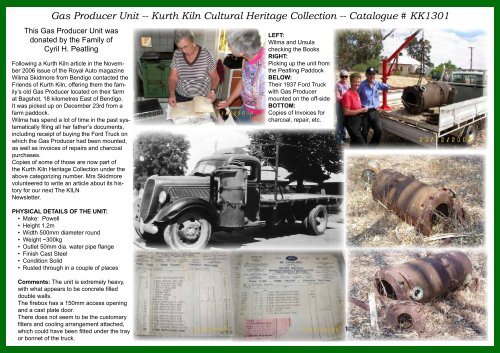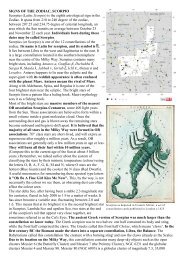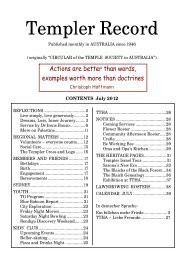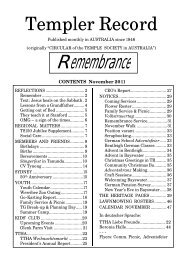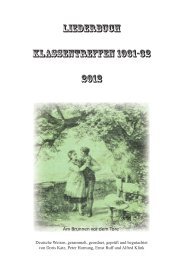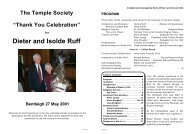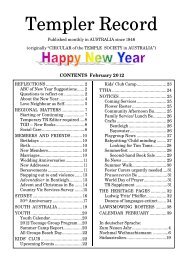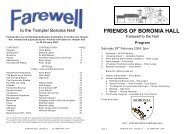Gas Producer Unit -- Kurth Kiln Cultural Heritage Collection ...
Gas Producer Unit -- Kurth Kiln Cultural Heritage Collection ...
Gas Producer Unit -- Kurth Kiln Cultural Heritage Collection ...
You also want an ePaper? Increase the reach of your titles
YUMPU automatically turns print PDFs into web optimized ePapers that Google loves.
<strong>Gas</strong> <strong>Producer</strong> <strong>Unit</strong> -- <strong>Kurth</strong> <strong>Kiln</strong> <strong>Cultural</strong> <strong>Heritage</strong> <strong>Collection</strong> -- Catalogue # KK1301<br />
This <strong>Gas</strong> <strong>Producer</strong> <strong>Unit</strong> was<br />
donated by the Family of<br />
Cyril H. Peatling<br />
Following a <strong>Kurth</strong> <strong>Kiln</strong> article in the November<br />
2006 issue of the Royal Auto magazine<br />
Wilma Skidmore from Bendigo contacted the<br />
Friends of <strong>Kurth</strong> <strong>Kiln</strong>, offering them the family’s<br />
old <strong>Gas</strong> <strong>Producer</strong> located on their farm<br />
at Bagshot, 18 kilometres East of Bendigo.<br />
It was picked up on December 23rd from a<br />
farm paddock.<br />
Wilma has spend a lot of time in the past systematically<br />
filing all her father’s documents,<br />
including receipt of buying the Ford Truck on<br />
which the <strong>Gas</strong> <strong>Producer</strong> had been mounted,<br />
as well as invoices of repairs and charcoal<br />
purchases.<br />
Copies of some of those are now part of<br />
the <strong>Kurth</strong> <strong>Kiln</strong> <strong>Heritage</strong> <strong>Collection</strong> under the<br />
above categorizing number. Mrs Skidmore<br />
volunteered to write an article about its history<br />
for our next The KILN<br />
Newsletter.<br />
physical details of the unit:<br />
• Make: Powell<br />
• Height 1.2m<br />
• Width 500mm diameter round<br />
• Weight ~300kg<br />
• Outlet 50mm dia. water pipe flange<br />
• Finish Cast Steel<br />
• Condition Solid<br />
• Rusted through in a couple of places<br />
comments: The unit is extremely heavy,<br />
with what appears to be concrete filled<br />
double walls.<br />
The firebox has a 150mm access opening<br />
and a cast plate door.<br />
There does not seem to be the customary<br />
filters and cooling arrangement attached,<br />
which could have been fitted under the tray<br />
or bonnet of the truck.<br />
left:<br />
Wilma and Ursula<br />
checking the Books<br />
Right:<br />
Picking up the unit from<br />
the Peatling Paddock<br />
Below:<br />
Their 1937 Ford Truck<br />
with <strong>Gas</strong> <strong>Producer</strong><br />
mounted on the off-side<br />
Bottom:<br />
Copies of Invoices for<br />
charcoal, repair, etc.
<strong>Producer</strong> <strong>Gas</strong><br />
• <strong>Producer</strong> <strong>Gas</strong> contains carbon monoxide as the working<br />
gas. It is made by passing air through a core of<br />
glowing charcoal at normal atmospheric pressure.<br />
• The temperature of the core should be above 900 degrees<br />
Celsius (or else you just get Carbon Dioxide)<br />
• The temperature can be as high as 1920 degrees Celsius<br />
• The temperature of the gas as it leaves the unit is<br />
about 700-800 degrees.<br />
• <strong>Producer</strong> <strong>Gas</strong> is a mixture of gases – mainly Nitrogen<br />
(N2) and Carbon Monoxide (CO) in the ratio of about<br />
2:1.<br />
• Keep in mind that for each unit of oxygen used in the<br />
process, four times as much nitrogen (by volume) joins<br />
the party. Being totally inert, the nitrogen passes along<br />
to the engine.<br />
• The first recorded producer was that of Bischof (1839),<br />
and 1st gas producer driven vehicle was built by J.W.<br />
Parker 1901. The early model producers were very<br />
cumbersome & heavy and even today producers are<br />
still manufactured along the same lines as the early<br />
German designs.<br />
• <strong>Gas</strong> producers can be fitted to a generator set, tractor,<br />
motor vehicle, or simply for heating purposes such as<br />
water heating, grain drying etc.<br />
The Friends of <strong>Kurth</strong> <strong>Kiln</strong> <strong>Cultural</strong> <strong>Heritage</strong> <strong>Collection</strong> KK1301-1<br />
4. History<br />
• Early development of producer gas …<br />
�1839 – Bischof (Germany).<br />
�1857 – Siemens Bros.<br />
�1860 – first successful gas engine.<br />
�1872 – used PG to power an airship.<br />
�1901 – PG used to power Car (Parker UK).<br />
• 1914-18 War – PG not even considered.<br />
• 1920-1935 – given serious consideration,<br />
particularly in remote areas.<br />
4.1 Research & Development …<br />
• Rennie (1930) – heavy units for Trucks.<br />
• woods (1938) – Rhodes Scholar.<br />
• dod - (1939) – prescriptive Manual.<br />
• csiR (1940) – Charcoal from Aust wood.<br />
• J&d cash (1940) – definitive text.<br />
• Bowden (WA - 1941) – GPU on Tractors.<br />
Wood <strong>Gas</strong> <strong>Producer</strong>s<br />
3. Social Snapshot …<br />
1901 1910 1920 1930 38-39 39-40 41-42 1946<br />
population<br />
(Vic)<br />
1.2 m 1.3 m 1.5 m 1.8 m 2.0 m<br />
private cars 151,130 121,129 138,385 143,356<br />
commercial<br />
Vehicles<br />
36,162 36,511 39,783 46,933<br />
primary<br />
producer<br />
Vehicles<br />
47,427 49,521 54,952 55,981<br />
Buses 438 636 689 716<br />
traction<br />
engines<br />
339 209 65 69<br />
Registered<br />
Vehicles<br />
(30) 2,700 27,000 170,000 235,496 208,006 233,874 247,055<br />
motorcycles 12,000 30,000 26,698 16,688 19,798 23,228<br />
licences 358,418 339,334 353,584 410,610<br />
Vic - 1941 : 421 people killed on roads (melb 60%). Bulge for 18-29 year age bracket<br />
nsw - 1940 – five people were killed riding scooters or billy-carts!<br />
3.1 Snapshot continued …<br />
• Minimum Weekly Wage 1939 - about £5.<br />
• £1 in 1939 � $72 in 2008.<br />
• MMTB tram miles increased by 2% in 1940-<br />
41 - resulting in 36% higher revenue!<br />
• GPU cost £45 - £70 ea in 1939 ⇒ $3 - 5000<br />
today<br />
• austin : £250 (in 1938 ⇒ $18 000 today).<br />
• Buick : £525 (1938) – if you could get one!<br />
• Petrol was 20 d per gallon in 1938.<br />
• CPI Adjusted 2008 price $1.32 per litre.
<strong>Gas</strong> <strong>Producer</strong> <strong>Unit</strong> -- <strong>Kurth</strong> <strong>Kiln</strong> <strong>Cultural</strong> <strong>Heritage</strong> <strong>Collection</strong> -- Catalogue # KK1302<br />
This <strong>Gas</strong> <strong>Producer</strong> <strong>Unit</strong> was given<br />
to us by Ray Young of Baxter<br />
Following our article in the November 2006<br />
RACV Magazine, Mr. Ray Young from Baxter<br />
contacted the Friends of <strong>Kurth</strong> <strong>Kiln</strong>, informing<br />
them of a Charcoal Burner <strong>Unit</strong> he knew<br />
was sitting abandoned in a paddock on a<br />
farm nearby.<br />
On Friday 15th December Alfred and Ursula<br />
met Ray and his friend Vince on site and<br />
looked at the <strong>Unit</strong>. Ray then kindly asked the<br />
owners of the farm if they would be prepared<br />
to donate it to the Friends of <strong>Kurth</strong> <strong>Kiln</strong> <strong>Heritage</strong><br />
<strong>Collection</strong>. They readily agreed, but did<br />
not want to be identified, and Ray then made<br />
the arrangements for the <strong>Gas</strong> <strong>Producer</strong> <strong>Unit</strong><br />
to be collected the next day.<br />
The Friends of <strong>Kurth</strong> <strong>Kiln</strong> sincerely thank Ray<br />
Young for all his help and assistance in organising<br />
the <strong>Gas</strong> <strong>Producer</strong> <strong>Unit</strong> for our collection<br />
and look forward to welcoming him<br />
for a visit at <strong>Kurth</strong> <strong>Kiln</strong> one day.<br />
Ray, who is quite a collector of historic folklore<br />
himself, promised to one day write something<br />
about the history of this particular <strong>Gas</strong><br />
<strong>Producer</strong> for our biannual newsletter.<br />
physical details of the unit:<br />
• Height 1.2m - overall<br />
• Width 1m - overall<br />
• Weight ~200kg<br />
• Construction: The central oval boiler unit<br />
is flanged by two round containers interconnected<br />
with 50mm tubing. The <strong>Unit</strong> is<br />
fitted with a hinged mounting facility.<br />
• Finish mild steel sheeting with some cast<br />
steel doors and fittings.<br />
• Condition Solid, but rusted through in a<br />
number of places where it had lain in the<br />
dirt. Especially the interconnected containers.<br />
• Comments Some fittings found lying next<br />
to the unit may have been part of a water<br />
drip system.<br />
clockwise from top left:<br />
• Amongst brambles and blackberries on a Baxter farm<br />
• Ursula, friend Vince and Ray Young on the paddock site<br />
• Name Plate, barely readable: Cheney - Pederick<br />
• Some of unidentified additional bits lying next to it<br />
• Heavy hinge pins for mounting on large Vehicle<br />
• Standing chest-high to Ray, it is a substantial unit<br />
• All loaded, the site cleaned up ready to go home
FOREWORD to the<br />
Pederick 1942 Pocket Owner’s Manual<br />
It should be clearly understood by operators accustomed to<br />
driving on petrol that they must learn to drive on an entirely<br />
new fuel. If they approach the task with an open mind and<br />
take the trouble to learn the construction and function of<br />
various components of the unit, then the extra controls will<br />
be clear to them, also various symptoms will be recognised<br />
and understood.<br />
THE two main components of the “Pederick” <strong>Gas</strong> <strong>Producer</strong><br />
are:<br />
• The Generator in which the Charcoal is burned to produce<br />
gas, and<br />
• The Cleaners for filtering the <strong>Gas</strong><br />
the geneRatoR<br />
This is a large cylinder, sometimes described as the hopper,<br />
which holds the Charcoal. It has a large hinged lid at<br />
the top for filling, and a smaller door at the bottom for cleaning<br />
purposes. At the bottom, on one side, cut under, is the<br />
“Pederick” patent fire plate, through which there is a hole to<br />
admit the air to the fire (this patent fire plate is used in the<br />
“Pederick” instead of a costly water cooled “tuyere” of limited<br />
life). There is also a compartment alongside this fire plate<br />
into which the air is first drawn through the two pipes seen<br />
on either side---- this is done by the suction of the engine.<br />
The air, passing the fire plate (which gets almost red hot in<br />
operation), is preheated before it enters the Generator, and<br />
at the same time cools the fire plate as it passes right across<br />
its face and thus prevents its destruction.<br />
A removable plug, inserted on the outer side of the air compartment,<br />
in line with the hole through the fire plate, is removed<br />
to insert the lighting taper, and is replaced when the<br />
Charcoal lights up.<br />
the cleaning system<br />
The Cleaning and Filtering of the <strong>Gas</strong> is done in five stages:<br />
• The Primary Cleaner, a cylinder fitted to the Generator<br />
• The Oil Cleaner<br />
• the Sisal Cleaner<br />
• The Woodwool Cleaner<br />
• The Final Felt Cleaner is sometimes fitted to the front of<br />
the vehicle, thus dispensing with the necessity of additional<br />
cooling systems.<br />
The Friends of <strong>Kurth</strong> <strong>Kiln</strong> <strong>Cultural</strong> <strong>Heritage</strong> <strong>Collection</strong> KK1302-1<br />
Grateful Acknowledgement is made of<br />
the Pederick Family for the 1942 Owners<br />
Manual, and to Don Bartlett for references<br />
to the Cash Book<br />
o ::c<br />
......."<br />
z<br />
~p~<br />
(')<br />
>-<br />
::c:<br />
CJ)<br />
the cash Book<br />
Probably the best known text on the use of producer gas was written by<br />
John & Martin Cash of Kew, Victoria. Called “<strong>Producer</strong> <strong>Gas</strong> for Motor Vehicles”<br />
it was published in 1940. The stated aim of the book was to contribute<br />
to the solving of Australia’s wartime transport problem. It offered<br />
factual information for the enlightenment of “engineers, garage-men, students<br />
and experimenters” as a form of protection against the “extravagant<br />
claims of over-enthusiastic salesmen”. It has survived as the definitive<br />
bible on the techno-practical side of producer gas.<br />
Some points from the Cash book are :<br />
• Fuel consumption is between 0.8 and 1 lb of charcoal per bhp hour.<br />
• The GPU is effective without the addition of water or steam.<br />
• Although water does increase the power, it takes heat from the system,<br />
which is not always a good thing.<br />
• The GPU is an inconvenient, bulky and in most cases, unsightly<br />
piece of apparatus but you must balance your prejudice against the<br />
fact that it enables you to move around.<br />
• <strong>Producer</strong> gas is less efficient than petrol. About 10 000 BThU are<br />
required to produce 1 horse-power.
<strong>Gas</strong> <strong>Producer</strong> <strong>Unit</strong> -- <strong>Kurth</strong> <strong>Kiln</strong> <strong>Cultural</strong> <strong>Heritage</strong> <strong>Collection</strong> -- Catalogue # KK1303<br />
Two <strong>Gas</strong> <strong>Producer</strong>s donated<br />
by the Solomano Family<br />
In January 2007 we had a phone call from<br />
Les Solomano from Talbot (near Maryborough)<br />
with an offer of two old <strong>Gas</strong> <strong>Producer</strong>s<br />
they had on their sheep farm as part of a collection<br />
of period farm equipment. “We were<br />
going to fix them up ourselves one day” Les<br />
said, “but just never seem to get around to<br />
it. So, if we give them to you for your historic<br />
display, at least they may still serve a practical<br />
purpose”. We picked the units up on 1<br />
February 2007 and loaded them on our truck<br />
with the help of Les and his son Neil. They<br />
gave us a guided tour of their huge collection<br />
of historic farm machinery, as well as a<br />
look into their new sheering shed. “You have<br />
to be versatile to make a living as a farmer<br />
these days”. Neil also finds work as a parttime<br />
actor and says he did have a small part<br />
in “The Man from Snowy River”.<br />
The Solomanos acquired the two <strong>Gas</strong> <strong>Producer</strong>s<br />
at some clearance sale, but may have<br />
some details of the manufacturer on one of<br />
them and what it was once used for.<br />
Les’ wife Joy prepared a lovely lunch for us<br />
physical details of unit 1:<br />
• Height 0.9m - overall<br />
• Width 1.3m overall<br />
• Weight ~ 120kg<br />
• Construction: bare welded mild steel<br />
sheeting with some cast steel doors<br />
• The rectangular boiler unit sits on one<br />
side, a round filter drum on the other side<br />
and the radiator fitted in between.<br />
• The assembly sits on a welded frame<br />
• Condition: The thin material is rusted<br />
through in a number of places<br />
• Comments: The <strong>Unit</strong> appears to be a<br />
backyard construction for a stationary<br />
engine installation. Some fittings found<br />
next to the unit may have been part of a<br />
water drip system.<br />
clockwise from left:<br />
• Les, Ursula and Neil, all<br />
loaded up ready to go.<br />
• Alfred, Les and Neil organising<br />
the large unit<br />
• This pipe may be part of<br />
a water drip system?<br />
• Les explaining how he<br />
feels it all goes together<br />
• The intricacies of their<br />
new wool-press<br />
• The Large <strong>Unit</strong> being<br />
loaded<br />
• Below, the wool-sorting<br />
table, wool-classing and<br />
the sheep
BUILDING YOUR OWN<br />
WOOD GAS GENERATOR<br />
The following fabrication instructions describe the prototype<br />
gasifier unit shown schematically. These instructions<br />
are simple and easy to follow. It will be obvious to the experienced<br />
engineer, mechanic, or builder that most of the<br />
dimensions (for example, plate thicknesses and clean-out<br />
diameters) are not critical to the acceptable performance of<br />
the finished gasifier unit.<br />
This prototype was actually constructed and field tested on<br />
a gasoline engine farm tractor (a 35-hp, John Deere 1010<br />
Special). The unit operated very well, and on par with the<br />
European, World War II designs, but it has not had the test<br />
of time nor the millions of operating hours like the older<br />
Imbert design. This new stratified design was developed for<br />
the construction of simple, inexpensive emergency wood<br />
gas generator units. The design should be considered the<br />
absolute minimum in regard to materials, piping and filter arrangement,<br />
and carburettor system connections.<br />
The gasifier unit is designed to maintain proper cooling,<br />
even at moderate vehicle speeds. The ideal temperature<br />
for the wood gas at the inlet to the carburettor manifold<br />
would be 70F, with acceptable peaks of 140F. For every 10<br />
degrees above 70F, an estimated 1% horsepower is lost.<br />
Cooler gas has higher density and, therefore, contains more<br />
combustible components per unit volume.<br />
The millions of wood gasifiers built during World War II<br />
proved that shape, form, and construction material had little<br />
effect on the performance of the units. Judicious substitution<br />
or the use of scavenged parts is, therefore, quite acceptable.<br />
What is important is that:<br />
• the fire tube dimensions (inside diameter and length)<br />
must be correctly selected to match the rated horsepower<br />
of particular engine which is to be fuelled<br />
• air tightness of the gas generator unit and all connecting<br />
piping must be maintained at all times<br />
• unnecessary friction should be eliminated in all air and<br />
gas passages by using appropriate pipe sizes and<br />
avoiding sharp bends in the piping.<br />
The Friends of <strong>Kurth</strong> <strong>Kiln</strong> <strong>Cultural</strong> <strong>Heritage</strong> <strong>Collection</strong> KK1303-1
<strong>Gas</strong> <strong>Producer</strong> <strong>Unit</strong> -- <strong>Kurth</strong> <strong>Kiln</strong> <strong>Cultural</strong> <strong>Heritage</strong> <strong>Collection</strong> -- Catalogue # KK1304<br />
Two <strong>Gas</strong> <strong>Producer</strong>s donated<br />
by the Solomano Family<br />
In January 2007 we had a phone call from<br />
Les Solomano from Talbot (near Maryborough)<br />
with an offer of two old <strong>Gas</strong> <strong>Producer</strong>s<br />
they had on their sheep farm as part of a collection<br />
of period farm equipment. “We were<br />
going to fix them up ourselves one day” Les<br />
said, “but just never seem to get around to<br />
it. So, if we give them to you for your historic<br />
display, at least they may still serve a practical<br />
purpose”. We picked the units up on 1<br />
February 2007 and loaded them on our truck<br />
with the help of Les and his son Neil. They<br />
gave us a guided tour of their huge collection<br />
of historic farm machinery, as well as a<br />
look into their new sheering shed. “You have<br />
to be versatile to make a living as a farmer<br />
these days”. Neil also finds work as a parttime<br />
actor and says he did have a small part<br />
in “The Man from Snowy River”.<br />
The Solomanos acquired the two <strong>Gas</strong> <strong>Producer</strong>s<br />
at some clearance sale, but may have<br />
some details of the manufacturer on one of<br />
them and what it was once used for.<br />
Les’ wife Joy prepared a lovely lunch for us<br />
physical details of the units 1 & 2:<br />
• Height 0.9m - overall<br />
• Width 1.3m overall<br />
• Weight ~ 120kg<br />
• Construction: bare welded mild steel<br />
sheeting with some cast steel doors<br />
• The rectangular boiler unit sits on one<br />
side, a round filter drum on the other side<br />
and the radiator fitted in between.<br />
• The assembly sits on a welded frame<br />
• Condition: The thin material is rusted<br />
through in a number of places<br />
• Comments: The <strong>Unit</strong> appears to be a<br />
backyard construction for a stationary<br />
engine installation. Some fittings found<br />
next to the unit may have been part of a<br />
water drip system.
BUILDING YOUR OWN<br />
WOOD GAS GENERATOR<br />
The following fabrication instructions describe the prototype<br />
gasifier unit shown schematically. These instructions<br />
are simple and easy to follow. It will be obvious to the experienced<br />
engineer, mechanic, or builder that most of the<br />
dimensions (for example, plate thicknesses and clean-out<br />
diameters) are not critical to the acceptable performance of<br />
the finished gasifier unit.<br />
This prototype was actually constructed and field tested on<br />
a gasoline engine farm tractor (a 35-hp, John Deere 1010<br />
Special). The unit operated very well, and on par with the<br />
European, World War II designs, but it has not had the test<br />
of time nor the millions of operating hours like the older<br />
Imbert design. This new stratified design was developed for<br />
the construction of simple, inexpensive emergency wood<br />
gas generator units. The design should be considered the<br />
absolute minimum in regard to materials, piping and filter arrangement,<br />
and carburettor system connections.<br />
The gasifier unit is designed to maintain proper cooling,<br />
even at moderate vehicle speeds. The ideal temperature<br />
for the wood gas at the inlet to the carburettor manifold<br />
would be 70F, with acceptable peaks of 140F. For every 10<br />
degrees above 70F, an estimated 1% horsepower is lost.<br />
Cooler gas has higher density and, therefore, contains more<br />
combustible components per unit volume.<br />
The millions of wood gasifiers built during World War II<br />
proved that shape, form, and construction material had little<br />
effect on the performance of the units. Judicious substitution<br />
or the use of scavenged parts is, therefore, quite acceptable.<br />
What is important is that:<br />
• the fire tube dimensions (inside diameter and length)<br />
must be correctly selected to match the rated horsepower<br />
of particular engine which is to be fuelled<br />
• air tightness of the gas generator unit and all connecting<br />
piping must be maintained at all times<br />
• unnecessary friction should be eliminated in all air and<br />
gas passages by using appropriate pipe sizes and<br />
avoiding sharp bends in the piping.<br />
The Friends of <strong>Kurth</strong> <strong>Kiln</strong> <strong>Cultural</strong> <strong>Heritage</strong> <strong>Collection</strong> KK1304-1<br />
WAR TIME GAS PRODUCERS<br />
courtesy Arthur Watson<br />
Any one who legally drove a vehicle fitted<br />
with a gas producer in war time Australia<br />
would now be in there eighties. I can<br />
remember the unit fitted to a vehicle producing<br />
a coke coal, gas that would drive<br />
the car engine without the use of petrol.<br />
Petrol was rationed, you were supplied<br />
with just enough to travel 40 miles per<br />
week. War time fuel shortages forced a<br />
very strict control with the issue of petrol<br />
The gas producer saved the day and they<br />
were made available for about $200.<br />
The principle of the GPU was to convert<br />
solid fuel wood, coke, coal, into a usable<br />
gas capable of being burnt in the petrol<br />
engine providing the power to drive the<br />
car.<br />
The GPU was a tricky bit of gear, not like<br />
a car, where one added fuel ,petrol, then<br />
turned the key and away you would go.<br />
With the gas producer having been serviced,<br />
which may take an hour or so to<br />
do, you were still required to start up and<br />
run the unit before enough gas has been<br />
made to take you on your way. Lighting<br />
up the coke, coal, wood, laden hopper,<br />
then setting the radiator for the correct<br />
water drip, and finally making sure the<br />
fuel flow valve to the engine manifold was<br />
set for smooth running could take half an<br />
hour or more.<br />
But then <strong>Gas</strong> <strong>Producer</strong>s gave us a very<br />
good fuel substitute, like all the other<br />
things the Government gave us during<br />
the War, they helped us to win.
<strong>Gas</strong> <strong>Producer</strong> <strong>Unit</strong> -- <strong>Kurth</strong> <strong>Kiln</strong> <strong>Cultural</strong> <strong>Heritage</strong> <strong>Collection</strong> -- Catalogue # KK1305<br />
A <strong>Gas</strong> <strong>Producer</strong> donated by the<br />
Falla Family of Donald<br />
The last call we received in response to our<br />
article in the November 2006 issue of the<br />
Royal Auto magazine was in February 2007<br />
from David Falla in Donald. David is a wheat<br />
farmer in the Wimmera who also collects historic<br />
items in a huge shed. Old wool presses,<br />
an original Land Rover, Wagons, Furphy Water<br />
Cart, Chaff Cutters, Tractors, Harvesters<br />
and much much more. And he breeds pigeons<br />
as a side line. Hidden amongst all that<br />
was an Electrolux <strong>Gas</strong> <strong>Producer</strong>, in reasonable<br />
condition. “We were going to do something<br />
with it, one day” David said, “but ‘one<br />
day’ never seems to come; we are just too<br />
busy and will never got around to it. So, you<br />
may as well have it for your collection”<br />
David’s father, Ray Falla, who is a bit of a<br />
historian, promised to chase up some of the<br />
background of <strong>Gas</strong> <strong>Producer</strong>s in Donald.<br />
With the help of Jasper and Carmel Hails we<br />
picked up the unit on 22 February in their<br />
roomy horse float.<br />
The physical details of unit are as follows:<br />
• Make - Electrolux<br />
• Height - 1.1m - overall<br />
• Width - 1.4m - overall<br />
• Weight ~150kg<br />
• Construction - The central oval shaped<br />
boiler unit is flanged by round and rectangular<br />
containers interconnected with a<br />
series of pipes. The unit is welded to an<br />
angle iron mounting frame<br />
• Finish - This appears to be a professionally<br />
made item, well finished with signs of<br />
the original paintwork still visible.<br />
• Condition - Stored indoors, the unit is in<br />
reasonable condition, with apparently all<br />
doors and fitting intact. Perhaps this unit<br />
could be made operational again.<br />
• Comments - The mounting arrangements<br />
would lend itself to a hinged fitting on a<br />
large car or truck.<br />
ckwise from left<br />
Ray Falla reading<br />
some of his historic<br />
notes<br />
Jasper Hails with the<br />
Filter Assembly<br />
Carmel Hails brushing<br />
off some of the<br />
cobwebs<br />
David Falla wheeling<br />
the Electrolux <strong>Gas</strong><br />
<strong>Producer</strong> up to the<br />
Hails’ horse float
FORESTS COMMISSION, VICTORIA<br />
STATE CHARCOAL BRANCH RAILWAY BUILDINGS.<br />
FLINDERS STREET, MELBOURNE. C.I<br />
30TH MARCH. 1942.<br />
Extracts from the<br />
plan foR incReasing pRoduction and co-oRdinating<br />
chaRcoal supplies foR VictoRia.<br />
The Government has directed the Forests Commission of<br />
Victoria to establish the State Charcoal Branch, and has<br />
arranged for the assistance of an Advisory Panel to take in<br />
hand the matter of stimulating the production of charcoal<br />
in sufficient quantities to provide for the ever-increasing<br />
number of <strong>Gas</strong> <strong>Producer</strong>s being fitted, as it is evident that<br />
the present rate of charcoal production will need to be trebled<br />
within the next few months, otherwise shortage will be<br />
such that Essential Services, in connection with the War Effort,<br />
may be seriously handicapped.<br />
Distribution of charcoal from the State Charcoal Branch’s<br />
depots in the metropolitan area and in the country will be to<br />
wholesale and Fleet Owners only.-- Retailing will be entirely<br />
through Local Garages.<br />
Charcoal is to be sold in weighted bags, labelled with<br />
• LIGHT Charcoal 40lb bag YELLOW Label 0-03-01d<br />
• MEDIUM Charcoal 45lb bag RED Label 0-04-01d<br />
• HEAVY Charcoal 50lb bag BLUE Label 0-04-06d<br />
The above prices, in all cases, are for a full bag of charcoal<br />
of regular wheat sack type. The weight variation of the bags<br />
from 40 lb. to 50 lb. is entirely due to the weight of the charcoal<br />
itself. It requires more wood to produce a given amount<br />
of light weight charcoal than it does of heavy charcoal. Also<br />
a garage man gives the same amount of service with a light<br />
as with a heavy bag, and, therefore, should be paid accordingly.<br />
These are the facts governing the Branch’s decision to sell<br />
Charcoal by the bag, and to have separate prices for Heavy,<br />
Medium and Light weight charcoal, or in other words, a price<br />
for the actual potential mileage to be obtained from the<br />
contents of the bag.<br />
ALL CORRESPONDENCE should be addressed to:<br />
The State Charcoal Branch,<br />
Railways Buildings, Flinders Street,<br />
MELBOURNE, C.l.<br />
The Friends of <strong>Kurth</strong> <strong>Kiln</strong> <strong>Cultural</strong> <strong>Heritage</strong> <strong>Collection</strong> KK1305-1
<strong>Gas</strong> <strong>Producer</strong> <strong>Unit</strong> -- <strong>Kurth</strong> <strong>Kiln</strong> <strong>Cultural</strong> <strong>Heritage</strong> <strong>Collection</strong> -- Catalogue # KK1306<br />
<strong>Gas</strong> <strong>Producer</strong> on permanent loan<br />
from Graeme Tibbett of Noble Park<br />
Having seen the <strong>Kurth</strong> <strong>Kiln</strong> article in the November<br />
2006 issue of the Royal Auto<br />
magazine, Graeme Tibbett rang us and offered<br />
a <strong>Gas</strong> <strong>Producer</strong> unit to he had as his<br />
place on an indefinite Loan Arrangement to<br />
the Friends of <strong>Kurth</strong> <strong>Kiln</strong> <strong>Heritage</strong> collection.<br />
On our meeting with him, later, he told us<br />
how he picked it up in Sydney a few years<br />
back at an auction.<br />
Mr Tibbett is an enthusiastic and experienced<br />
restorer of historic items and at that time still<br />
had plans to restore the <strong>Gas</strong> <strong>Producer</strong>. “I am<br />
getting too old now” he said, “ and rather than<br />
letting it collect dust in my shed I thought you<br />
might as well use it as part of your <strong>Kurth</strong><br />
<strong>Kiln</strong> collection.” Mr. Tibbett is well versed in<br />
the history and technology of <strong>Gas</strong> <strong>Producer</strong>s<br />
and has a collection of written material which<br />
he had studied and recommended as interesting<br />
reading.<br />
With the help of Jasper Hails we picked up<br />
the <strong>Unit</strong> on 18 December. The Friends of<br />
<strong>Kurth</strong> <strong>Kiln</strong> sincerely thank Mr Graeme Tibbett<br />
for letting us add his <strong>Gas</strong> <strong>Producer</strong> <strong>Unit</strong> to<br />
our historic collection.<br />
The physical details of the unit are as follows:<br />
• Make: TUSON’S Cross Draught<br />
• Model OFFICIAL Type 30hp Heavy Duty<br />
• Height 1.1m - overall<br />
• Width 1.2m - overall<br />
• Weight ~120kg<br />
• Construction: a commercially made unit<br />
with a solid round boiler on a steel base.<br />
A pressure cooker lid, filter and car-type<br />
radiator and some in- and outlet pipes.<br />
• Finish: unpainted steel and cast steel fittings.<br />
• Condition Solid, though some bits missing,<br />
has rust affected parts, but could<br />
possibly be restored<br />
• A badly deteriorated Manual was later<br />
discovered inside the unit.
My war-time experience with these devices<br />
by Graeme Tibbett<br />
My first vehicle fitted with a NASCa model, was a 1926<br />
Chrysler 60 Tourer. The unit was mounted on a heavy carrier<br />
attached to the back of the vehicle.<br />
It consisted of a hopper which from memory was about 2<br />
feet square and about 3 feet high. The air was admitted at<br />
the side of the hopper about 5-6 inches above the bottom<br />
through a fitting known as a tuyere (pronounced TWEE-ER)<br />
which was made of some ceramic material somewhat akin<br />
to fire bricks used in furnaces.<br />
The fire itself was not very large and was concentrated<br />
around the tuyere and as it burned the charcoal, so further<br />
charcoal would feed down from the hopper. The fire produced<br />
gas and ash and this had to be removed from time to<br />
time, from an ash trap at the bottom through a trapdoor.<br />
On the side of the unit was a gas filter through which the<br />
gas was passed to remove as much grit as possible before<br />
it was fed into the engine through a “T” fitting, with a butterfly<br />
valve usually fitted under the normal carburettor.<br />
The filter on my first unit consisted of, I think, four white<br />
felt bags over wire frames. They were about 12 inches by<br />
24 inches by 1 ~ inches thick and the gas passed from the<br />
outside to the inside of the bags. Dust was collected and fell<br />
into the ash trap. The gas hose from the unit to the engine<br />
was rubber, about 2 inches in diameter.<br />
To operate, the hopper was filled through the top opening<br />
with charcoal, the lid locked down and the motor started<br />
on petrol. The gas valve in the “T” fitting was cracked open<br />
then a piece of wire with a rag tied on the end was dipped<br />
in kerosene and lit and pushed into the tuyere where the<br />
flame was sucked into the charcoal and ignited it.<br />
One then got into the vehicle” and with the judicious use of<br />
the accelerator, “T” valve and choke, gas would be drawn<br />
into the engine and then the petrol would be shut off and<br />
everything was ready to go. This procedure took about<br />
13 minutes. Later models used an electric blower to start<br />
the process and so some petrol was saved. In my experience<br />
the motor only produced about 60¬70 per cent of the<br />
normal petrol engine, evens the gas unit was working at<br />
100%, due to lower thermal efficiency of gas compared to<br />
petrol. Other factors that reduced the efficiency of the system<br />
was the charcoal quality, which varied markedly in the<br />
wood it was made from and its moisture it contained.<br />
The Friends of <strong>Kurth</strong> <strong>Kiln</strong> <strong>Cultural</strong> <strong>Heritage</strong> <strong>Collection</strong> KK1306-1<br />
I later wondered if a motor bike would work on gas, so I<br />
bought a Harley Davidson outfit for 5 pounds ($10.00 - I<br />
wish I still had it today) and made a small unit to go on<br />
the back of the sidecar. The hopper was a five gallon<br />
drum modified to suit. The filter was one of Mother’s old<br />
sugar canisters, with a couple of quarts of old engine<br />
oil in the bottom, into which the incoming gas threw its<br />
heavy particles, then went up through some oily sisal.<br />
The Harley went<br />
well and I rode it<br />
from Brunswick<br />
to Maribynong<br />
every day to<br />
work until one<br />
day it came to<br />
a sad end when<br />
going through<br />
central Melbourne<br />
it backfired,<br />
and blew<br />
the bottom out<br />
of the filter and<br />
spread oil all<br />
over Elizabeth<br />
Street.


